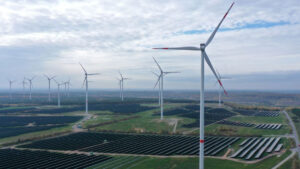Apollo’s Kroussou project is a stomping zinc-lead giant

Pic: Tyler Stableford / Stone via Getty Images
Drilling at Apollo’s Kroussou lead-zinc project in Gabon continues to support the potential for a large-scale, shallow, mineral system that’s suitable for open pit mining.
Results from the first six holes at the previously untested Niamabimbou prospect returned results such as 19.9m grading 1.6% zinc+lead from 8m including 5.7m at 3% zinc+lead from 22.2m and 19.9m at 1.6% zinc+lead from 13.5m including 4.5m at 2.8% zinc+lead.
Apollo Minerals (ASX:AON) notes that the average depth to mineralisation is less than 7m with drilling confirming the presence of shallow zinc and lead mineralisation that remains open with potential for further discoveries.
Drilling at Dikaki also continues to intersect mineralisation with results from an additional nine holes returning a top intercept of 23.2m at 2.4% zinc+lead from 36.1m including 10.9m at 3.1% zinc+lead from 39.9m.
Adding further interest, Niamabimbou and Dikaki are just two of the 18 prospects at the province-scale Kroussou project.
“The assay results returned from the first six holes at the previously untested Niamabimbou prospect are highly encouraging, and display similar mineralised geometries to the Dikaki prospect, which is located 16km to the north,” executive director Neil Inwood said.
“The company has now demonstrated thick, shallow zinc-lead mineralisation in two prospects in 2021; and will continue expanding on these two discoveries with a comprehensive exploration program planned for 2022.”
Drilling for the 2021 field season is now complete though assays are still pending for 34 holes at Niamabimbou and 12 holes at Dikaki.
Kroussou project
Kroussou covers nearly 1,000sqkm of ground in the Ngounié Province, western Gabon, where historical exploration work has resulted in the identification of 150 zinc-lead mineral occurrences over a +70km strike.
These are associated with 18 channels (prospects), of which only four have been drill-tested to date.
Apollo is currently earning into an 80% stake in Kroussou, which hosts at least 80km of strike that is prospective for near-surface zinc and lead mineralisation.
It needs to spend $2 million on exploration over its first three years to claim a 70% stake in the project and another $2m within five years to up its stake to the full 80%.
The project’s potential to host shallow, high-grade zinc-lead is particularly relevant as the world moves towards electrification.
Zinc is used in steel and as part of some rechargeable battery chemistries while lead is used in the well-proven lead-acid batteries that are still used as backup batteries in electric vehicles.
This article was developed in collaboration with Apollo Minerals, a Stockhead advertiser at the time of publishing.
This article does not constitute financial product advice. You should consider obtaining independent advice before making any financial decisions.
Related Topics
UNLOCK INSIGHTS
Discover the untold stories of emerging ASX stocks.
Daily news and expert analysis, it's free to subscribe.
By proceeding, you confirm you understand that we handle personal information in accordance with our Privacy Policy.








